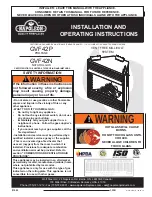
45
15.0
MAINTENANCE
15.1
GENERAL
KEEP APPLIANCE AREA CLEAR AND FREE FROM COMBUSTIBLE MATERIALS AND FLAMMABLE
VAPORS AND LIQUIDS.
A competent person should check and ensure that the flue system, ventilation to the plant room, safety valve,
drain, pressure gauge etc. are in a serviceable and working condition and still comply with the relevant standards
and codes of practice, as detailed in
Section 3.1 RELATED DOCUMENTS
.
Servicing is recommended at intervals no greater than 12 months to ensure trouble free operation. Even if the
maintenance schedule for the storage vessel is determined to be less than annually, it is important that all controls
and safety features are checked for correct operation on an annual basis.
Measuring flue gas CO
2
and flue gas temperatures will give an indication of the state of the flue and burner.
Results of the flue gas analysis should be compared with previously measured values to establish possible loss of
efficiency.
15.2
MAINTENANCE SCHEDULE
Waterborne impurities consist of the particles of soil and sand, which can settle out and form a layer of sediment
on the bottom of the tank. The amount of calcium carbonate (scale) released from water is in direct proportion to
water temperature and usage. The higher the water temperature or water usage, the more scale deposits are
dropped out of the water.
Scale accumulation not only reduces the life of the equipment but also reduces efficiency of the water heater and
increases fuel consumption. The usage of water softening equipment greatly reduces the hardness of the water.
However, this equipment does not always remove all of the hardness (scale). For this reason it is recommended
that a regular schedule of de-scaling be maintained.
The depth of the build-up should be measured after 3 months of operation to determine whether maintenance is
required. The heater will have about 76mm (3 inches) of scale build-up when the level of scale has reached the
bottom of the cleanout opening or about 25mm (1 inch) of scale build-up if it has reached the drain valve opening.
A schedule for de-scaling should be set up, based on the amount of time it would take for a 13mm (1/2-inch) build-
up of scale. If insufficient scale has built up on the base of the vessel, then the vessel should be cleared and a
longer period left before checking again to determine the required service interval.
15.3
DRAINING WATER HEATER SYSTEM
The water heater must be drained if it is to be shut down and exposed to freezing temperatures. Maintenance and
service procedures may also require draining the water heater.
1.
Turn off the water heater electrical isolator.
2.
Connect a hose to the drain valve.
3.
Locate hose’s discharge in an area where hot water will not cause any damage or injury.
4.
Close the cold water inlet valve to water heater.
5.
Open a nearby hot water outlet to vent the system.
6.
Open the heater drain valve.
7.
If the water heater is being drained for an extended shutdown, it is suggested the drain valve be left
open during this period.
Содержание LBF121
Страница 2: ......
Страница 4: ......
Страница 20: ...20 Fix the black flue hood casing to the heater using the screws supplied in the box ...
Страница 52: ...52 ...








































